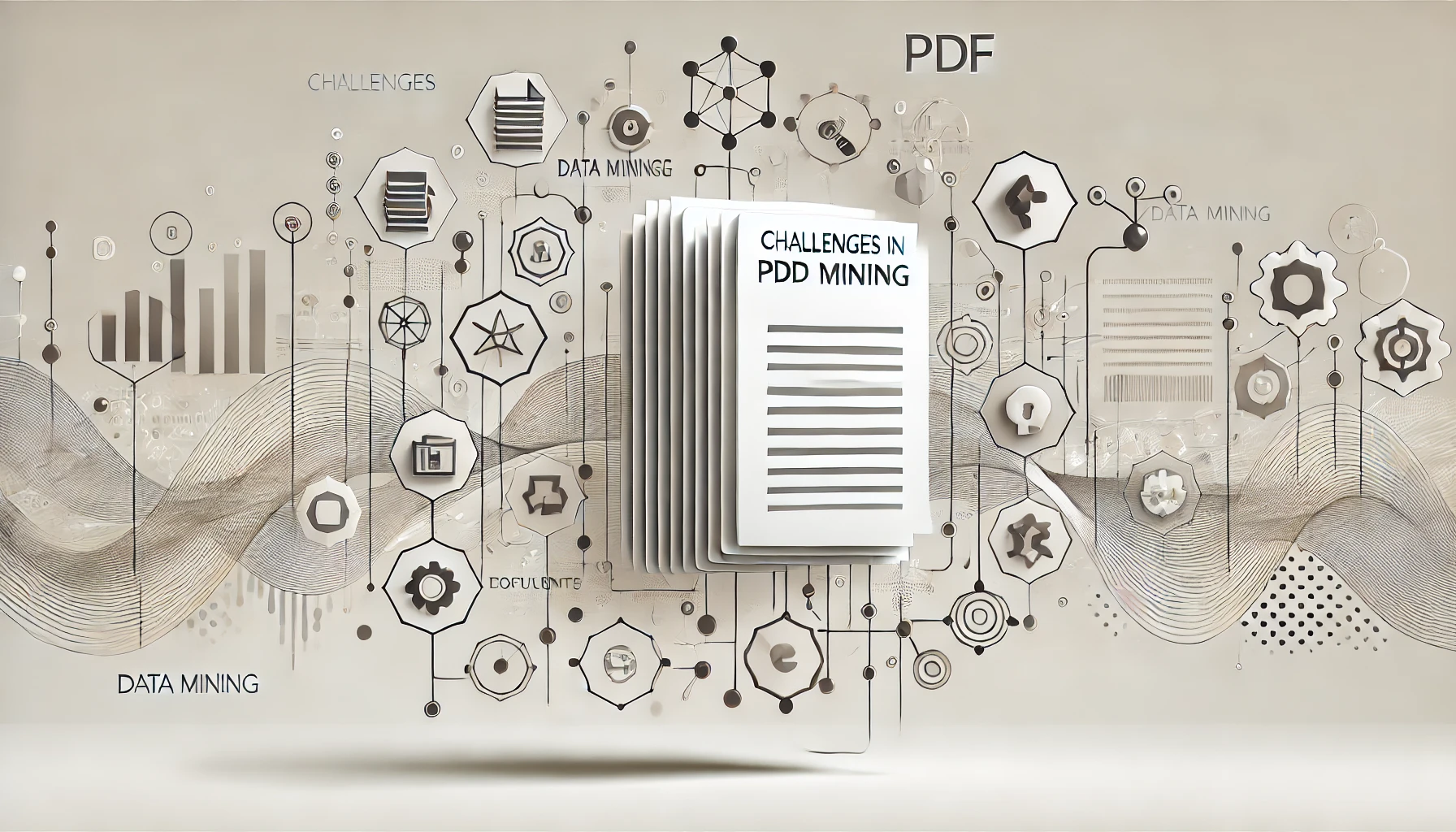Understanding the key differences between PDF Data Mining and Web Scraping can significantly impact your data extraction strategy. From the techniques employed to the tools required, each method offers distinct advantages and limitations that can shape your approach to gathering information. Dive into the realm of PDF data mining and web scraping to uncover the key disparities that could transform how you harness data for your endeavors.
Techniques
When comparing PDF data mining and web scraping techniques, it is essential to understand the distinct methods each process entails. Data extraction is a crucial aspect of both techniques, but the way it is performed differs significantly. In PDF data mining, data extraction involves parsing through the content of PDF files to retrieve specific information. This process requires specialized tools that can interpret the structure of the PDF document and extract relevant data accurately. On the other hand, web scraping focuses on extracting data from web pages by analyzing the HTML structure. Text processing is another key component that sets these techniques apart. In PDF data mining, text processing involves converting scanned documents or images into machine-readable text through OCR (Optical Character Recognition) technology. In contrast, web scraping deals with processing the text directly from the HTML content of web pages. Understanding these differences is essential for choosing the right technique based on the nature of the data source.
Data Quality
When considering data quality, it’s essential to address the accuracy of information extracted from PDFs and the reliability of data obtained from websites. PDF data mining may face challenges related to the accuracy of scanned or converted text, potentially leading to errors in the extracted data. In contrast, web scraping relies on the stability and consistency of websites, where changes in site structure or content can significantly impact the reliability of the extracted data.
Accuracy in PDFs
To achieve high accuracy in PDF data mining, it is crucial to understand the unique challenges that come with extracting information from this format. PDFs present specific obstacles that can impact data quality, making it essential to employ precise techniques for accurate extraction. Here are three key factors affecting accuracy in PDF data mining:
- File Structure Complexity: PDFs can have intricate structures, such as scanned images, embedded fonts, or tables, which can complicate text extraction processes and lead to inaccuracies.
- Text Recognition Errors: Optical Character Recognition (OCR) software is often used for text extraction in PDFs. However, OCR may introduce errors due to variations in fonts, layouts, or quality of the scanned document.
- Metadata Mismatch: Discrepancies between metadata information and actual content in PDF files can result in inaccuracies during data validation processes, impacting the overall accuracy of extracted data.
Addressing these challenges through advanced extraction techniques and meticulous validation processes is crucial for ensuring the accuracy of data mined from PDFs.
Reliability of Websites
Navigating the realm of web data mining entails a meticulous evaluation of the reliability of websites to ensure data quality. Trustworthiness is a critical aspect when considering the credibility of sources for web scraping. Reliable websites are characterized by accurate and up-to-date information, minimal errors, and a reputation for providing trustworthy content. Ensuring the credibility of sources is essential to extract accurate data for analysis and decision-making processes.
When assessing the reliability of websites for data mining, consider factors such as the website’s domain expertise, the authoritativeness of the content, and the presence of references or citations. Websites that are maintained by reputable organizations or experts in the field are more likely to offer reliable information. Verifying the accuracy and credibility of the sources before extracting data is fundamental to avoid inaccuracies or misleading insights.
Legal Considerations
While conducting PDF data mining or web scraping, it is crucial to be well-versed in the legal considerations surrounding these practices.
Legal considerations to keep in mind include:
- Ethical Implications:
- Ensure that the data being collected is done so ethically and does not infringe on the privacy rights of individuals or violate any ethical standards.
- Copyright Infringement:
- Respect copyright laws and only extract data from PDFs or websites that you have the right to access. Be cautious not to infringe on any intellectual property rights.
- Terms of Service:
- Familiarize yourself with the terms of service of the websites you are scraping data from. Some websites explicitly prohibit web scraping, and ignoring these terms could lead to legal consequences.
Applications
When considering the applications of PDF data mining and web scraping, it is essential to focus on the data extraction tools and data analysis techniques employed in each method. Data extraction tools play a crucial role in efficiently retrieving information from PDF documents and websites, while data analysis techniques are used to interpret and derive insights from the extracted data. Understanding the differences in how these tools and techniques are utilized can significantly impact the effectiveness and outcomes of data mining and web scraping processes.
Data Extraction Tools
Several data extraction tools play a crucial role in the processes of PDF data mining and web scraping. These tools are essential for efficiently extracting valuable information from various sources. Here are some key data extraction tools used in these processes:
- Tabula: This tool is commonly utilized for extracting tables from PDF documents. It uses text recognition algorithms to identify table structures and convert them into structured data that can be easily analyzed.
- Beautiful Soup: A popular Python library, Beautiful Soup is widely used for web scraping. It helps parse HTML and XML files, making it easier to extract specific data elements from web pages.
- Apache Tika: Apache Tika is a versatile tool that supports content extraction from a wide range of file formats, including PDFs. It uses advanced parsing techniques to extract text, metadata, and structured content from documents accurately.
Data Analysis Techniques
To effectively analyze the extracted data from PDFs and websites, utilizing appropriate data analysis techniques is paramount. Data analysis techniques play a crucial role in deriving valuable insights from the collected information. One key technique is data visualization, which involves presenting data in graphical or pictorial formats to uncover trends, patterns, and correlations that might not be apparent in raw data. By visualizing the data, you can easily identify outliers, relationships, and clusters, aiding in making informed decisions based on the findings.
Another essential technique is pattern recognition, which involves identifying recurring patterns or trends within the data. This technique is particularly useful in detecting anomalies, predicting future outcomes, and classifying data into distinct categories. By applying pattern recognition algorithms, you can automate the process of recognizing patterns in large datasets efficiently.
Dynamic Content
Analyzing dynamic content is a crucial aspect that distinguishes PDF data mining from web scraping. When it comes to web scraping, understanding how to handle dynamic content is key. Here’s how dynamic content affects PDF data mining and web scraping:
- JavaScript Rendering: In web scraping, dealing with dynamic content often involves parsing and executing JavaScript code to extract the necessary data. PDF data mining, on the other hand, doesn’t usually require handling JavaScript rendering.
- AJAX Requests: Web pages frequently use AJAX requests to dynamically load content. Web scraping tools need to manage these requests to access all the data. In contrast, PDF data mining focuses on extracting structured data from static PDF documents.
- Real-Time Updates: Dynamic content may change frequently due to real-time updates triggered by user interactions. Web scraping tools must continuously monitor and scrape updated content, while PDF data mining operates on static data snapshots.
Scalability
When comparing PDF data mining and web scraping in terms of scalability, it’s crucial to consider the handling of large datasets. Web scraping typically offers better scalability due to its ability to automate the extraction of data from multiple web pages efficiently. On the other hand, PDF data mining may face challenges when dealing with extensive datasets, requiring more manual intervention and processing.
PDF Vs Web Scalability
PDF and web scalability present distinct challenges when it comes to data mining and scraping.
PDF:
- PDFs are less scalable due to the nature of the format. They are designed for static document presentation rather than dynamic data extraction.
- Performance in PDF data extraction can be slower when dealing with large datasets. Parsing text from PDF files can be computationally intensive.
- Data volume in PDFs can impact scalability. Handling a large number of PDF files or very large PDF documents can strain resources and slow down the extraction process.
Web:
- Web scraping allows for greater scalability as web pages are designed for dynamic content delivery. This makes it easier to extract data from multiple pages efficiently.
- Web performance is generally better in web scraping due to the structured nature of web pages and the ability to navigate through links for data extraction.
- Data volume on the web can also be significant, but web scraping tools are often optimized to handle large amounts of data more effectively than PDF extraction methods.
Handling Large Datasets
Dealing with large datasets in data mining and web scraping poses distinct challenges that require efficient handling methods to ensure optimal performance. When it comes to data storage, managing vast amounts of information extracted through web scraping or data mining processes is crucial. Proper data storage techniques, such as utilizing databases or cloud storage solutions, are essential for organizing and accessing large datasets efficiently.
Performance optimization is another critical aspect when handling large datasets. In data mining, optimizing algorithms and processing techniques can significantly enhance the speed and efficiency of extracting valuable insights from massive amounts of data. Similarly, in web scraping, implementing strategies like asynchronous processing or distributed computing can help improve performance when dealing with extensive datasets scraped from multiple sources.
Tools
To efficiently extract data from various sources, including PDF files and websites, you will need to utilize distinct tools tailored for each task. When it comes to data extraction and content scraping, specific tools are essential for maximizing efficiency and accuracy. Here are three key tools commonly used for PDF data mining and web scraping:
- PDF Data Mining Tools:
- Tabula: Ideal for extracting data tables from PDFs.
- PyPDF2: Allows for extracting text and metadata from PDF files.
- PDFMiner: Useful for accessing text content and layout information from PDFs.
- Web Scraping Tools:
- BeautifulSoup: A Python library for pulling data out of HTML and XML files.
- Scrapy: An open-source and collaborative web crawling framework.
- Selenium: Great for automating web browsers and scraping dynamic web pages.
- General Data Extraction Tools:
- Apache Tika: Supports extraction of text and metadata from various document formats.
- Octoparse: Enables easy web scraping without coding.
- Import.io: A platform for extracting data from websites and turning it into structured datasets.
Unstructured Data
When handling unstructured data, such as text documents or web pages, it is crucial to employ effective data mining and scraping techniques to extract valuable insights. Text extraction plays a vital role in converting unstructured data into structured data, allowing for easier analysis and interpretation. Techniques like natural language processing can aid in extracting meaningful information from textual content, enabling the identification of patterns and trends within the data.
In addition to text extraction, image processing is essential for dealing with unstructured data that contains visual content. By utilizing image recognition algorithms, data miners can extract valuable insights from images, such as identifying objects, people, or locations. Metadata extraction is another crucial aspect of handling unstructured data, as it helps in extracting important information about the data itself, including timestamps, author information, and geolocation data.
Multimedia Extraction
Moving beyond text and image extraction, multimedia extraction represents a more advanced stage in handling unstructured data. This process involves extracting and analyzing multimedia content such as videos, audio files, and interactive elements to derive meaningful insights. Here are some key aspects of multimedia extraction:
- Image Recognition: Utilizing advanced algorithms and machine learning techniques, image recognition technology can identify objects, text, scenes, and even emotions within images. This allows for automated tagging, categorization, and analysis of visual content.
- Content Extraction: Multimedia extraction involves not only identifying multimedia elements but also extracting relevant content from them. This could include transcribing audio files, generating captions for videos, or converting handwritten text in images into editable digital text.
- Data Enrichment: By combining multimedia extraction with traditional text data mining techniques, organizations can enrich their datasets with a wider variety of information. This leads to more comprehensive insights and a deeper understanding of the data at hand.
Privacy Concerns
Amid the growing landscape of data extraction techniques, privacy concerns have emerged as a critical aspect that demands careful consideration. When engaging in PDF data mining or web scraping, it is essential to prioritize data protection and ethical considerations to safeguard individuals’ private information. PDF data mining involves extracting data from documents that may contain sensitive personal or confidential details. Similarly, web scraping collects information from various online sources, potentially accessing user data without explicit consent.
To mitigate privacy risks, it is vital to adhere to legal regulations such as GDPR and ensure that data extraction methods are conducted ethically and transparently. Implementing measures like anonymization of extracted data, obtaining consent when necessary, and securely storing information are crucial steps in addressing privacy concerns. By prioritizing data protection and ethical considerations in PDF data mining and web scraping practices, individuals can uphold privacy standards and build trust with users whose data is being accessed.
Frequently Asked Questions
Can PDF Data Mining Extract Data From Scanned Documents?
Yes, PDF data mining cannot perform scanned text recognition. It faces data extraction limitations with scanned documents because it cannot interpret text from images. For this task, specialized OCR (Optical Character Recognition) software is needed.
How Can Web Scraping Handle Websites With Complex Authentication Systems?
To handle websites with complex authentication systems, you need to explore authentication handling methods like session management, cookies, and user-agent rotation. Implementing Captcha bypass techniques can also help streamline web scraping processes for such websites.
Are There Any Restrictions on Using Web Scraping for Competitor Analysis?
Imagine you’re a detective navigating a maze of legality and ethics. Web scraping for competitor analysis has legal implications; be cautious of data accuracy and reliability. Consider ethical considerations when diving into this digital investigation.
What Are the Limitations of PDF Data Mining for Extracting Tables or Charts?
When mining PDFs, data accuracy can be compromised due to varying file structures. Formatting challenges arise when extracting tables or charts, often requiring manual intervention for interpretation. These limitations hinder efficient data extraction processes.
How Can Web Scraping Handle Websites With Constantly Changing Layouts?
When dealing with dynamic websites with ever-changing layouts, you must employ adaptive scraping techniques. These methods allow you to adjust your scraping process in real-time to extract data accurately despite the constant shifts in webpage design.



